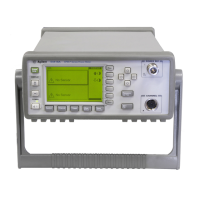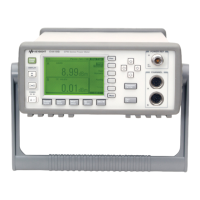Performance Tests 2
E4416A/E4417A Power Meters Service Guide 37
This specification includes the ±0.4% setting and also takes into account other
factors that will contribute to determining the accuracy after 2 years. The
complete breakdown of the ±0.5% specification is as follows:
• Test line limit: 0.1%.
• System uncertainty: 0.3%.
• 2 year oscillator drift: 0.04%.
• Delta environment: <0.06%.
The same equipment used to measure the accuracy of the power reference
oscillator can also be used to set it to the post- factory accuracy of ±0.4% (for
further information refer to Chapter 3, “Adjustments”).
The following procedure ensures maximum accuracy in measuring power
reference oscillator output using Agilent test instruments of known capability.
Signal acquisition criteria may vary if alternative test instruments are used. In
such cases refer to the manufacturer's guidelines for further information.
The test is performed using Equation 2- 4:
Equation 2-4: Power Level Provided By The Reference Oscillator
The components of this equation are defined as follows:
• V
0
is the voltage measured between V
comp
and V
RF
with no power applied
and after the Agilent 432A has been zeroed.
• V
1
is the voltage measured between V
comp
and V
RF
with power applied. This
power is approximately 1 mW.
• V
comp
is the voltage between the Agilent 432A V
comp
connector and chassis
ground with power applied.
• R is the resistance of the mount resistor in the Agilent 432A power meter.
For further information refer to Appendix A.
• Calibration Factor is the value of the thermistor mount at 50 MHz
P
meas
2V
comp
V
1
V
0
–()V
0
2
V
1
2
–+
4R CalibrationF actor()
-------------------------------------------------------------------=
Artisan Technology Group - Quality Instrumentation ... Guaranteed | (888) 88-SOURCE | www.artisantg.com

